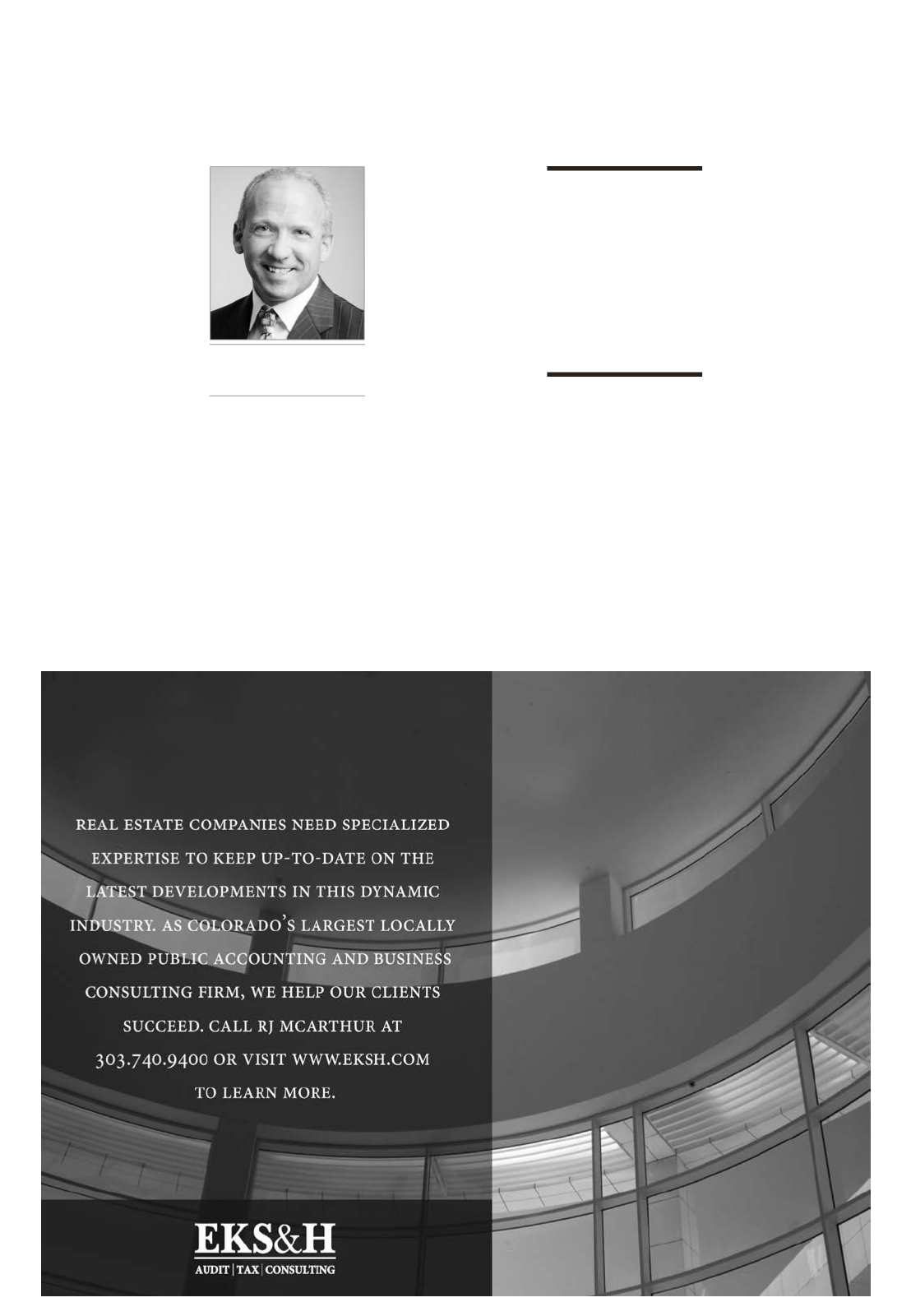
Page 10AA —
COLORADO REAL ESTATE JOURNAL
— December 3-December 16, 2014
W
ith the end of 2014
just around the
corner, it is that
time of year to consider year-
end tax planning strategies.
Four general areas financial
executives should be reviewing
include: 1) timing year-end
income and expenses; 2)
credits, deductions, and
incentives that may change in
2014 or 2015; 3) the impacts
to businesses from health care
legislation; and 4) approaching
changes to revenue
recognition.
n
Income and expense
deferral and acceleration.
Depending on expected tax
bracket in the upcoming year,
there are many income and
expense timing techniques
businesses should consider
as year-end approaches.
The traditional strategy is to
defer income into next year
and accelerate deductible
expenditures into this year if
you expect to be at nearly the
same or a lower tax bracket
next year. Alternatively, if you
expect your business to grow
significantly, resulting in a
higher tax bracket in 2015,
you should take the opposite
approach.
At the most basic level,
companies should consider
methods to accelerate or post-
pone economic performance.
This can be achieved through
income strategies (i.e.,
accelerating/postponing
economic performance,
entering/selling installment
contacts, and accelerating/
delaying billable services) or
expense strategies (i.e., altering
payment schedules for state
estimated tax installments,
paying contractor bills, and
bonus distribution). Other
important strategies may
include holding or selling
appreciated assets, structuring
or avoiding like-kind exchange
treatment, or altering business
structure between pass-through
and C Corporation.
n
Year-impacted Credits,
deductions and incentives.
As of the time this article was
written, legislation to extend
many popular, temporary tax
extenders was being considered
by the lame duck congress.
Legislation could be passed
impacting many tax strategies
in late 2014 or early 2015.
Regardless, the following issues
are important for real estate
and construction companies to
consider:
(1) Repair Regulations.
The
adopted final regulations for
treating costs associated with
tangible property may create
tax planning opportunities.
For acquisitions of tangible
property, a safe harbor applies
to items costing $5,000 or less.
However, businesses must have
a written policy in place at
the beginning of the year that
specifies a dollar amount for
the book treatment.
(2) Bonus Depreciation,
Section 179 and Section 179D.
Bonus depreciation expired
at the end of 2013 and at the
date of this article it is not
known whether Congress will
extend bonus depreciation for
2014 and beyond. There have
been indications that Congress
is leaning toward extending
bonus depreciation along
with an increased section 179
deduction limits and Section
179D for energy-efficient
commercial buildings as part
of a lame duck Congress tax-
extender package. We likely
won’t know the outcome of this
until late December or even
early January.
(3) Cost Segregation.
Companies may elect to
accelerate cash flow benefits of
depreciation deductions via a
thorough review of depreciable
building components. In
particular, it is important to
do a cost segregation study
for buildings purchased or
inherited within the past five
years.
(4) 1031 Tax Straddling.
With
the end of 2014 approaching,
some investors may be leery of
selling properties if they are
unsure whether to initiate a
1031 exchange because they
may be unable to close on
a replacement property to
complete it. However, with “tax
straddling,” taxpayers may still
receive a one-year tax deferral
thanks to installment sale
rules that could defer the gain
on the open 1031 exchange
to 2015 if you were unable
to close on you replacement
property.
(5) Small Employer Health
Insurance Expense Credit.
Eligible employers with 10 or
fewer employees (and full-time
equivalents) are allowed a 50%
credit for certain contributions
made to purchase health
insurance for their employees.
The credit begins to phase out
for employers with 25 or more
employees.
n
Affordable Care Act
impacts.
As of Jan. 1, 2015, the
PPACA’s “employer mandate”
(employer shared responsibility
requirements) takes effect for
select applicable large employers
(ALEs), depending on size.
ALE determination is based on
number of employees, including
full-time equivalents, during any
consecutive six month period in
2014.
RJ McArthur
Partner, EKS&H, Denver
At the most
basic level,
companies
should consider
methods to
accelerate or
post-pone
economic
performance.


